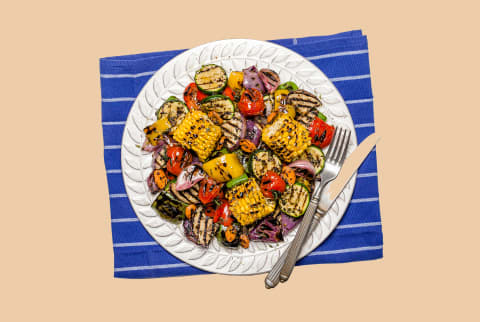Advertisement
4 Essential Tips For Vegetarian Grilling


Much about barbecue cooking is learning "on the job," and if you do it often, you quickly learn what works for you and what doesn't. Here are a few things to think about:
Heating-up time
With a chimney starter and decent fuel, you can get a charcoal barbecue ready to cook on in around 10 to 15 minutes. Without a chimney starter, it's more like 30 or perhaps even a little more. A gas grill will take around 10 minutes to heat up, which is about the same time as a griddle on the hob. Heating up a plancha from cold will add an additional 10 minutes to heating-up time.
All barbecues will have hot spots and cool spots. This is actually a good thing, as you can move food around to suit its heat requirements. With a gas grill, learn where they are, and with a charcoal grill, learn how to create them (see below).
Direct and indirect grilling
Simply put, you either grill directly, over the fire, or indirectly, off to the side of the fire, or you can cook on both, which you could call two-zone cooking. You can configure your charcoal arrangement in different ways: a ring around the edge, or a pile in the middle with the edges clear, or (the way I usually do it) a sort of half-and-half arrangement with coals on one side and nothing the other. To achieve this with a gas barbecue, you simply leave some of the burners unlit and use that side to cook indirectly. I would always advise you to set up your charcoal barbecue for two-zone cooking—if there is an even layer of coals all over, you have no wriggle room to move things away from the fire if they are cooking too quickly.
With a griddle pan, you can achieve something vaguely similar to two-zone cooking by starting veg off on a cold griddle so they begin to soften as it heats up. This is useful for grilling something dense like slices of butternut squash. If your grill spans two rings on the hob, even better—you just don't light one half, and the heat will transfer across the griddle in a much more gentle way on the unlit side.
How hot is too hot?
Vegetables can often take a higher direct heat than meat—there are no collagen fibers to tighten and toughen up and no particularly critical or safe internal temperatures to worry about. So in that sense they are often easier.
It's good to consider the different cooking requirements of different vegetables, as that will affect whether you choose direct or indirect cooking methods, or indeed opt for a bit of both. So something like delicate asparagus will cook best over a quick, high heat, whereas the dense flesh of parsnips is best given the low and slow treatment. In some cases, like with cauliflower or carrots, the ideal thing is a brief plunge into boiling water to start off the cooking process before finishing off on the grill.
When you want to cook different veg at the same time and in the same place—as on a kebab skewer—try to make all the pieces evenly sized so they all come into contact with the grill. If the veg in question have wildly different cooking needs, you are best off threading and cooking on separate skewers.
Smoking vegetables
For the same reasons as above, you can run the barbecue slightly hotter when you smoke vegetables than you would if you were smoking meat. Temperature is not quite so critical. However, some recipes are definitely designed to take as long as possible for the best results.
To create smoke for flavor, you have three options. The first, using whole wood logs, is great if you are cooking on an open fire, not so great on a barbecue with a lid, as there will be too much smoke and it's all a bit harder to control. The next option, and my preferred one, is little chunks of wood that you can add bit by bit as you go. I would start smoking by adding about three to my fire, then top up with the odd one or two now and then. Thirdly, you can buy bags of smoking chips, which usually say to soak them in water before you use them so they don't burn too fast. I have tried soaking and not soaking and generally prefer the latter, just adding them more frequently. When the chips are wet, you get something of a damp and rather acrid smoke, which is not altogether desirable. It's worth noting that the hotter the fire, the less smoke effect you get and that a more gently burning fire will smoke more.
Once you get into smoking, you can experiment with all sorts of different woods to give slightly different flavors. My standard go-to wood for smoking vegetables is little Jenga bricks of oak.
You can smoke on a gas grill—it's not as easy, but it's possible. A few come with tubes you can fill with smoking chips and rest over the burners, or you can put the chips into a tin tray and do the same thing. I wouldn't use chunks of wood on a gas grill.
Thinking about what veggies you're going to toss on the grill? Try eggplant or asparagus—or even romaine lettuce (trust us!)